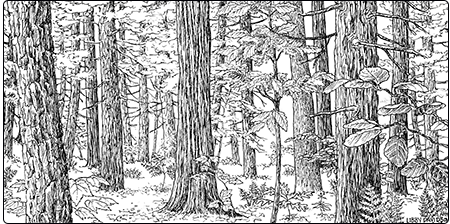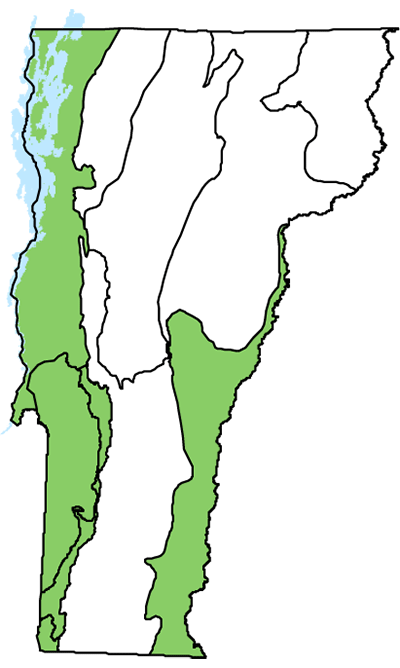Ecology and Physical Setting
Dry Hemlock-Oak Forests sprawl over low hills in the warmer regions of southern Vermont. This community is widespread in states to our south and reaches the edge of its range here. It is primarily found on acidic, shallow-to-bedrock soils but can also occur on well-drained glaciofluvial or glaciolacustrine deposits. These soils hold little moisture, and annual precipitation is low, so drought is a constant stress.
Vegetation
Eastern hemlock is abundant, comprising 25 to 75 percent of the canopy. Red oak, white oak, black birch, and beech are common hardwood associates. Black oak and hickories may also be present. The presence of species near their northern range limits defines this community. In some cases, tall white pines form an emergent super-canopy. Sugar maple and yellow birch are never abundant. Shrubs and herbs are scattered in the understory, and are almost absent when hemlock is most abundant. Frequent shrubs include maple-leaved viburnum and witch hazel. Many herb species can be found in this community, but most are dry forest generalists. These include marginal wood fern, bracken fern, rough leaf rice-grass, wintergreen, and woodland sedge.
Wildlife Habitat
Dry Hemlock-Oak Forest is an important mixed forest habitat of southern Vermont, especially the Southern Vermont Piedmont and Taconic Mountains. The abundance of acorns benefits many wildlife species, such as white-tailed deer, wild turkey, and many small mammals. Porcupine, fisher, and bobcat are all common in these forests. Particularly when found on sunny, south-facing slopes where snow melts quickly, Dry Hemlock-Oak Forests provide deer winter habitat. The hemlock canopy also holds snow and reduces snow depths on the forest floor.
There are many migratory birds that nest in Dry Hemlock-Oak Forest, including blue-headed vireo, wood thrush, ovenbird, Blackburnian warbler, and scarlet tanager. Broad-winged hawks typically nest in the crotches of deciduous trees, while barred owls favor nests in large hollow trees of mature forests. Cooper’s hawk and sharp-shinned hawk are uncommon breeders in Vermont. Both can be found nesting in Dry Hemlock-Oak Forest.
The dry, warm ground conditions are favorable for the rare eastern ratsnake, which is found in parts of the Taconic Mountains, and the North American racer, which is found in southeastern Vermont. Small areas of ledge can provide basking sites.
Successional Trends

Black birch is a common early successional species in this forest following disturbance. Droughty conditions probably help maintain the presence of mid-successional species like red oak. In the absence of disturbances, hemlock and beech are likely the dominant canopy species.
Variants
- Hemlock-Oak-Mountain Laurel Forest occurs in extreme southeastern and southwestern Vermont. Mountain laurel forms a dense understory, often excluding all other vegetation. American chestnut sprouts echo the former glory of this magnificent tree. In southern New England, this forest type is widespread.
Related Communities
- Hemlock-Northern Hardwood Forest also has a mix of hemlock and hardwood species, but the cooler climate favors northern species such as sugar maple, yellow birch, and hobblebush. White oak, chestnut oak, and hickory species are absent. Red oak can be present in both Hemlock-Northern Hardwood Forests and Dry Hemlock-Oak Forests.
- Dry Transition Hemlock Forest has over 75 percent cover of hemlock in the canopy, with occasional red oak, white oak, chestnut oak, and black birch.
- Mesic Maple-Ash-Hickory-Oak Forest has a greater abundance of southern hardwoods such as white oak and shagbark hickory, and hemlock comprises less than 25 percent of the canopy. It is found on richer sites.
Conservation Status and Management Considerations
Dry Hemlock-Oak Forest is an uncommon community in the state but its distribution is not fully known. A few of the known occurrences are on conserved lands, but there are likely many additional examples that are not protected. The hemlock woolly adelgid threatens the long-term survival of hemlock in these forests. If forest management is undertaken, maintaining healthy hemlocks as part of a diverse canopy will help foster the long-term resilience of this community.
Distribution/Abundance
This is an uncommon community in Vermont. It is found at lower elevations in the southern half of the state. The largest known examples are found in the Southern Vermont Piedmont and Taconic Mountains. Similar communities are found in neighboring states, and are widespread in southern New England.
Characteristic Plants
Trees
Abundant Species
Eastern hemlock – Tsuga canadensis
Red oak – Quercus rubra
American beech – Fagus grandifolia
White oak – Quercus alba
Black birch – Betula lenta
Occasional to Locally Abundant Species
Chestnut oak – Quercus montana
Black oak – Quercus velutina
Shagbark hickory – Carya ovata
Bitternut hickory – Carya cordiformis
White pine – Pinus strobus
Hophornbeam – Ostrya virginiana
American chestnut – Castanea dentata
Shrubs
Abundant Species
Maple-leaved viburnum – Viburnum acerifolium
Witch hazel - Hamamelis virginiana
Occasional to Locally Abundant Species
Low sweet blueberry – Vaccinium angustifolium
Late low blueberry – Vaccinium pallidum
Beaked hazelnut – Corylus cornuta
Mountain laurel – Kalmia latifolia
Sweet fern – Comptonia peregrina
Herbs
Occasional to Locally Abundant Species
Bracken fern – Pteridium aquilinum
Marginal wood fern – Dryopteris marginalis
Christmas fern – Polystichum acrostichoides
Indian cucumber root – Medeola virginiana
Rough leaf rice-grass – Oryzopsis asperifolia
Wintergreen – Gaultheria procumbens
Indian pipes – Monotropa uniflora
Woodland sedge – Carex pensylvanica
Partridgeberry – Mitchella repens
Bastard toadflax – Comandra umbellata
Wild oats – Uvularia sessilifolia
Blue-stemmed goldenrod – Solidago caesia
Rare and Uncommon Plants
Scarlet oak – Quercus coccinea
Sassafras – Sassafras albidum
Mountain laurel – Kalmia latifolia
Spotted wintergreen – Chimaphila maculata
Large whorled pogonia – Isotria verticillata
Associated Animals
Eastern red-backed salamander – Plethodon cinereus
Gray treefrog – Hyla versicolor
Porcupine – Erethizon dorsatum
White-tailed deer – Odocoileus virginianus
Black bear – Ursus americanus
Fisher – Pekania pennanti
Bobcat – Lynx rufus
Eastern gray squirrel – Sciurus carolinensis
Black-billed cuckoo – Coccyzus erythropthalmus
Blue-headed vireo – Vireo solitarius
Hermit thrush – Catharus guttatus
Wood thrush – Hylocichla mustelina
Ovenbird – Seiurus aurocapilla
Black-throated green warbler – Setophaga virens
Black-throated blue warbler – Setophaga caerulescens
Blackburnian warbler – Setophaga fusca
Scarlet tanager – Piranga olivacea
Tufted titmouse – Baeolophus bicolor
Hairy woodpecker – Picoides villosus
Pileated woodpecker – Dryocopus pileatus
Broad-winged hawk – Buteo platypterus
Barred owl – Strix varia
Wild turkey – Meleagris gallopavo
Rare and Uncommon Animals
North American racer – Coluber constrictor
Eastern ratsnake – Pantherophis alleghaniensis
Northern long-eared bat – Myotis septentrionalis
Cooper’s hawk – Accipiter cooperii
Sharp-shinned hawk – Accipiter striatus
Places to Visit
Pond Woods Wildlife Management Area, Benson and Orwell, Vermont Fish and Wildlife Department (VFWD)
Roaring Brook Wildlife Management Area, Vernon, VFWD
